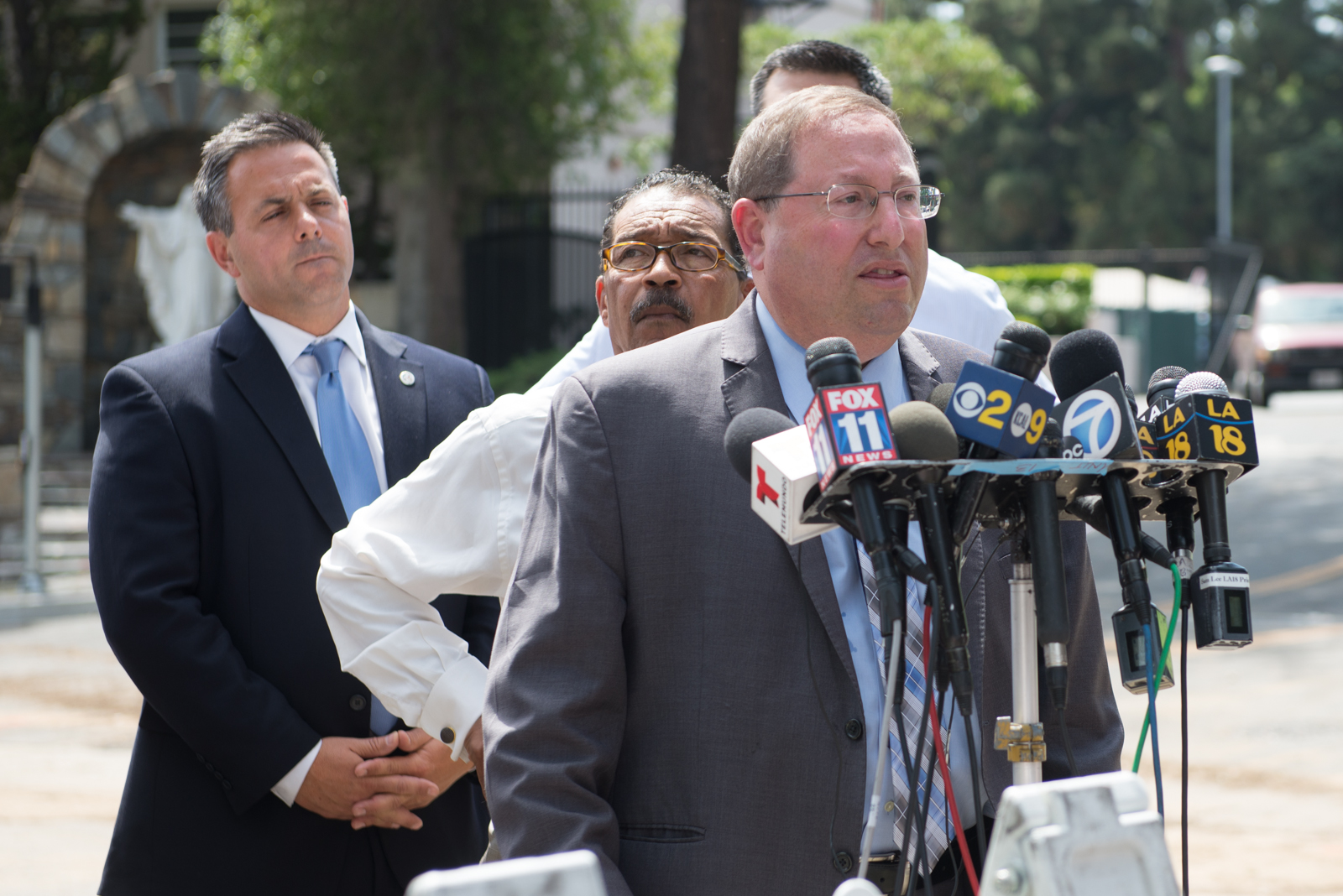City councilmembers urge LADWP to report cause of water main break

City councilmember Paul Koretz spoke at a press conference near UCLA about the water main break Wednesday. (Brandon Choe / Daily Bruin)
By Daily Bruin
July 30, 2014 5:27 p.m.
This post was updated at 8:08 p.m.
Two Los Angeles city councilmembers are demanding that the L.A. Department of Water and Power report the cause of the water main break that flooded campus Tuesday and possible infrastructure problems that led to the break, in a motion released Wednesday evening.
The motion was introduced by Councilmembers Paul Koretz and Herb J. Wesson, Jr. Koretz represents the 5th District, which includes UCLA.
Specifically, the councilmembers are asking the department to report the water main’s operational history, whether it was scheduled for repairs or maintenance and steps the department is taking to minimize leaks. Councilmembers cited technology to preemptively identify water system failures as a step they would like LADWP to report.
Paul Neuman, director of communications for Koretz’s office, said that although the water main break on Sunset Boulevard is no longer “innately critical,” Koretz and other councilmembers are concerned about the impact of future infrastructure failures on the UCLA and Westwood communities.
“It is a huge concern that, in any city, infrastructure be sound,” Neuman said. “There is a need to figure out what happened and how capable the response was on every level. There’s also that issue of figuring out what our level is in ensuring maximum safety in any accident or mishap.”
About 7,000 miles of distribution lines span the city, and about three to four pipe breaks occur each day, said Jane Galbraith, LADWP spokeswoman. Usually, pipe breaks come from mains that are 6 to 8 inches in diameter, she added.
LADWP is working on a $2 billion project over the next 10 years to improve the infrastructure’s reliability, according to a February department report. Because of the department’s financial constraints, the project’s budget has been reduced by approximately $380 million since the previous fiscal year, the report said.
For the 2013-14 fiscal year, LADWP is aiming to replace approximately 130,000 feet of main water lines in the city, according to the report. From 2006 to 2013, about 145 cumulative miles of water mains were replaced and annual water main breaks decreased by nearly 40 percent, the report said.
The department experiences about three or four water pipe breaks per day, though most are small, said Jim McDaniel, senior assistant general manager at LADWP, in a press conference Wednesday.
Henry McCann, a project manager at the Luskin Center for Innovation who specializes in water resource management and policy, said that LADWP has about 200 water main breaks per year that require significant repairs. Many officials, including those at LADWP, said the water main break on Tuesday was the city’s largest since the Coldwater Canyon water main break in 2009.
The 20 million gallons of water that leaked are equivalent to what more than 15,000 residents use in a day, said Mark Gold, acting director at the UCLA Institute of the Environment and Sustainability.
Nearly a quarter of L.A.’s water infrastructure, including pipes, are more than 100 years old, Gold said. He added that because a lot of water infrastructure was built when the city was less than a 10th of its current size, the water infrastructure is having a hard time handling the capacity.
The cost of fixing the city’s water infrastructure could be many billions of dollars, and that doing so could be intrusive to residents, especially commuters, McCann said. Because most pipes are under roads, improving pipes means stopping traffic for hours and possibly days at a time, he said.
McCann said he thinks city officials do not have a sense of urgency when it comes to fixing the water infrastructure because Los Angeles has separate systems for storm drain and sewage. This means that residents do not see much of an environmental impact from keeping decades-old water mains, McCann said.
Both McCann and Gold said they would like to see the city prevent water from being wasted in cases similar to Tuesday’s flood. Both proposed an expansion of wastewater treatment facilities to clean water for use by the city.
LADWP officials have said they cannot yet identify the cause of the break because they are still working to stop the flooding, and that they plan to update the public as they learn more about the situation. LADWP is starting its repair of the main by cutting through the pipe. Department workers then plan to insert a “balloon plug” into the pipe to help stop the water flow.
Read the full motion below.
Compiled by Jeong Park, Andrew Erickson, Amanda Schallert and Sam Hoff, Bruin senior staff.


